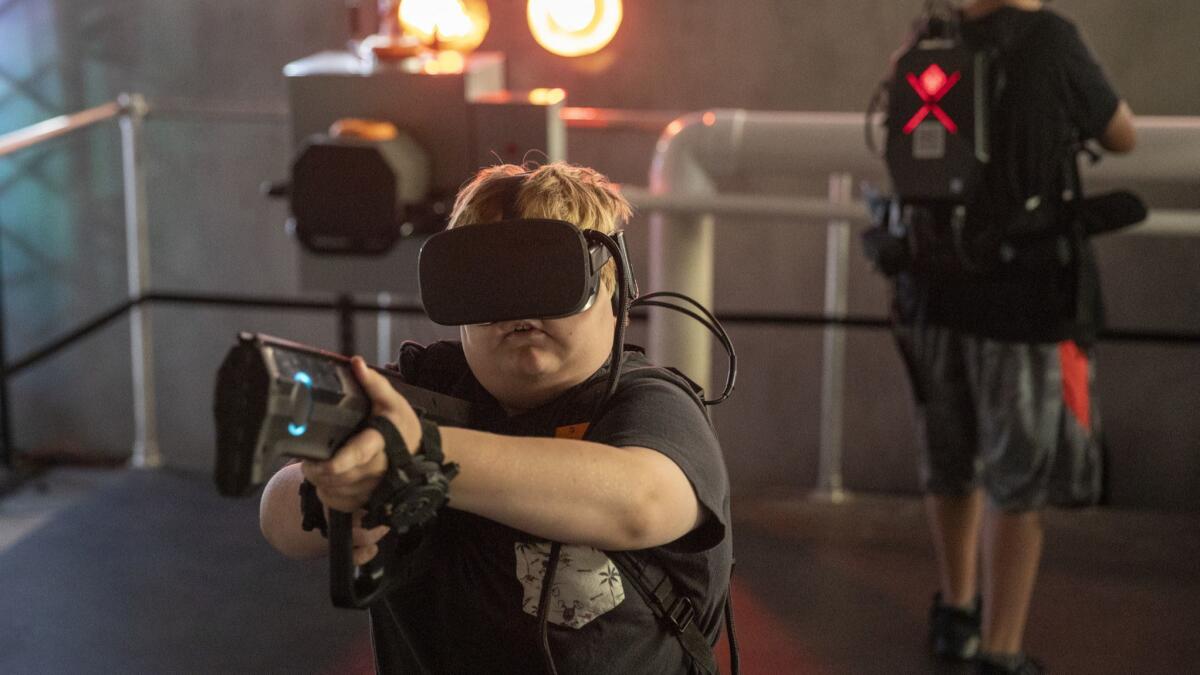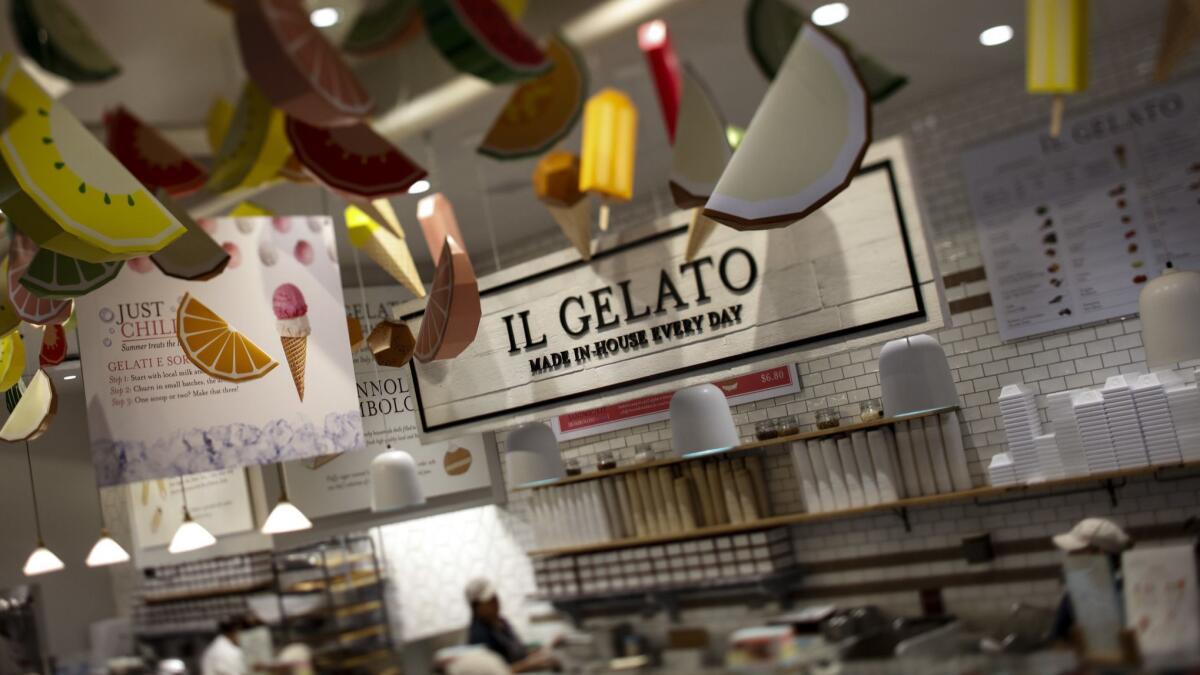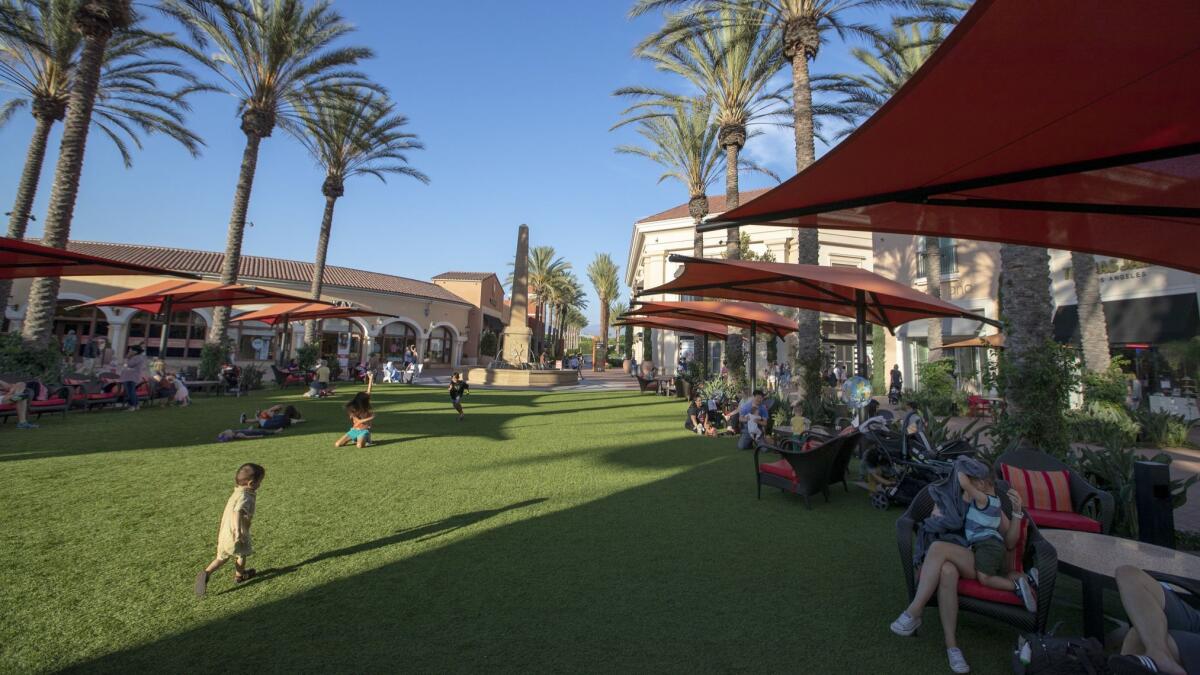America’s malls are dying. Owners are hoping virtual reality and fitness centers will save them

- Share via
A row of old kitchen equipment is all that remains of the Red Robin restaurant that left the Irvine Spectrum Center in June. Now, the air conditioning cools powerful computers, high-tech headsets and dozens of high-definition screens.
The traditional shopping mall menu of burgers and brews has made way for “Terminator Salvation: Fight for the Future,” a virtual reality attraction based on the “Terminator” film franchise. And since the late-August opening, it has attracted visitors who said they hadn’t been to a mall in months.
For the record:
11:35 a.m. Sept. 11, 2018A prior version of this story mistakenly called the Westfield Century City mall the Westfield Culver City mall in one reference.
“I brought my brother up from San Diego to play and it was so realistic,” said Karen Lopez, a college student who stayed afterward, bought some food and did a little late-afternoon shopping “to hopefully avoid at least one rush hour on the way back.”
Mall operators are trying out virtual reality and other non-retail concepts, including luxury health and fitness offerings and haute cuisine, to combat rising vacancy rates brought about by the success of Amazon.com and other e-tailers. The effect has been compounded by the millennial generation’s buying habits, which lean toward spending on restaurants and activities rather than in stores.
Merchants have been closing at such a rapid pace that financial services company Credit Suisse recently predicted 20% to 25% of U.S. malls will shut down within five years.
To survive, malls need to set aside long-established models that rely on two or more anchor tenants to draw customers and, instead, develop a mixture of retail, entertainment and housing, said Michael J. Brown, a partner and retail specialist at consulting firm A.T. Kearney.
“Move away from retail to pulling in consumers,” Brown said, “and switch from a primary focus on just selling things to creating consumer engagement.”
Southern California has sprouted some prime examples of this new type of mall in developer Rick Caruso’s upscale Grove and Americana at Brand ventures.
More recently, Westfield Century City unveiled its $1-billion overhaul that last year turned an aging outdoor mall into a Westside hot spot with about half of its offerings devoted to eating, drinking and other pursuits.

The three-level Eataly Italian market and restaurant complex is perpetually packed. Equinox opened one of its luxury fitness emporiums there, as did the Next Health wellness center, which features cryotherapy chambers and customized IV drips. A start-up called Forward offers concierge medical services at Westfield Century City and soon will open at Americana at Brand.
“The redo of the Westfield Century City mall has been very successful,” said retail trend analyst Phil Lempert, editor of SupermarketGuru.com.
This decade’s great retail shakeout hit the Irvine Spectrum Center hard in 2016. It lost an anchor tenant as the Macy’s department store chain began closing dozens of stores nationwide.
Owner Irvine Co. responded with a $200-million revamp that involved tearing down the empty Macy’s and replacing it with 30 small trendsetting retailers and restaurants, several of which opened in August with others launching through next year.
The mall’s “Terminator” attraction is among a smattering of virtual reality tenants moving into shopping centers with an eye toward providing the kind of experience-based outing that millennial consumers are said to crave.
The Outlets at Orange shopping center houses a virtual reality experience tied to the “Alien” sci-fi movie franchise called “Alien: Descent.” It was created by Pure Imagination, which licensed the rights from 20th Century Fox.
Earlier this year, Westfield Century City hosted a different “Alien” virtual reality pop-up attraction created by Dreamscape Immersive called “Alien Zoo.”
In March, Glendale Galleria became home to “Star Wars: Secrets of the Empire,” a virtual reality attraction where visitors wearing computer-filled backpacks and VR goggles move through a course to complete a mission. The company behind the attraction, Lindon, Utah-based Void, operates another “Star Wars” VR attraction at Downtown Disney as well as other themed VR experiences in Las Vegas, New York and abroad.

Finding unusual and alluring tenants is one thing, but making fundamental changes in the way malls are structured and operated is a much more difficult and expensive undertaking, analyst Lempert said.
“The cost to renovate these aging shopping centers is extraordinary. In some cases, it will probably be cheaper just to rip them down,” Lempert said.
The Irvine Spectrum Center’s owner determined that it had to do more than just fill vacant storefronts. Butch Knerr, president of Irvine Co. Retail Properties, said the $200 million spent on the project was one of the biggest investments made since the mall opened in 1995.
In the old days, malls would replace a lost anchor like Macy’s with another big-box retailer, but Knerr said his company went in a different direction to drive more consumer engagement and revenue. Four new buildings on the southeastern edge of the center are being used to house 30 new boutique, bespoke stores and restaurants.
“We know that people want a very convenient, comfortable environment with lots of experiences,” Knerr said. “They can shop, be entertained, hang out with their kids.”
Knerr, who has been with Irvine Co. for about a year, counts landing the “Terminator” VR entertainment center as among his first accomplishments.
The VR attraction is operated by Burbank-based Spaces, whose chief executive, Shiraz Akmal, describes the company this way: “We take physical spaces and transform them into digital playgrounds.”
“We have been overwhelmed by the interest,” Akmal said. “At 11 p.m. at night, on a weeknight, this place is still busy with people shooting Terminators.”
For more business news, follow Ronald D. White on Twitter: @RonWLATimes
More to Read
Inside the business of entertainment
The Wide Shot brings you news, analysis and insights on everything from streaming wars to production — and what it all means for the future.
You may occasionally receive promotional content from the Los Angeles Times.











